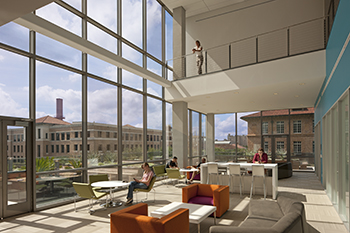CO Architects Take on UT Austin Master Plan
 AUSTIN, Texas — The University of Texas Austin (UT Austin) campus is an historic site full of historic buildings. Though the original 40-acre campus has been expanded over the years, the university developed a well-intentioned master plan and building guidelines that would help preserve the character and integrity of its 1930s-era structures. However, when CO Architects of Los Angeles was tasked with developing a new high-tech science building within that historic core, the project provided an ideal opportunity to challenge the previously referential master plan and bring campus aesthetics into the 21st century.
AUSTIN, Texas — The University of Texas Austin (UT Austin) campus is an historic site full of historic buildings. Though the original 40-acre campus has been expanded over the years, the university developed a well-intentioned master plan and building guidelines that would help preserve the character and integrity of its 1930s-era structures. However, when CO Architects of Los Angeles was tasked with developing a new high-tech science building within that historic core, the project provided an ideal opportunity to challenge the previously referential master plan and bring campus aesthetics into the 21st century.
The UT Austin campus was originally master planned by the Beaux Arts architect Paul Cret of Philadelphia. Within the original core there are a number of iconic Italianate and Romanesque-style buildings that have received — or are eligible for — national register designation.
Within this context, CO Architects needed to design a facility to house modern research and teaching space for the College of Natural Sciences, which includes the college’s molecular bioscience, chemistry, organic chemistry and neuroscience disciplines. That building, the 295,000-square foot Norman Hackerman Building, would require state-of-the-art facilities and much more program space than the school’s existing chemistry building, Welch Hall, which was erected in 1929, allowed.
“[Welch Hall] was no longer well suited for modern science,” said Andrew Labov, AIA, LEED AP, principal at CO Architects. “Contemporary research is really about promoting collaboration and providing shared access to sophisticated equipment. It requires buildings that are much deeper and fatter to get more program on the same floor, and we weren’t able to adapt the existing building, which was very narrow.”
Renovating Welch Hall with laboratories that were less systems-intensive, and demolishing the adjacent 1950s-era Experimental Science Building, which did not have historical significance, became the obvious solution, allowing CO Architects a wider and deeper site to on which to establish the Norman Hackerman Building floor plate. “In order to do that we temporarily relocated seven mature oak trees, then brought them back after the building was finished,” said David Johnson, AIA, LEED AP, an associate principal at CO Architects.
However, an additional hurdle in the $126 million project came in the form of the university’s most recent master plan, which was completed in the late 1990s, requiring that new construction adhere to the existing aesthetic of tripartite wall organization and clay tile roofs. Designing a modern, sustainable science facility that met these requirements inspired CO Architects to challenge the master plan guidelines and urge university officials to embrace alternatives.
“The question became, ‘how do you build a modern science building whose goal was to achieve LEED Gold in the middle of this original, historic 40-acre core of the campus?’” Labov said. “The Norman Hackerman Building has the largest solar hot water array in Texas, and trying to marry that with a clay tile aesthetic — and not just look like we were mounting solar panels on a clay tile roof — really required some changes to the aesthetics. We actually had to go to the Board of Trustees for the university to get approval for changes to the master plan.”
This approach inspired trustees to update the master plan to allow for greater flexibility in integrating sustainable design solutions, doing away with the clay tile roof mandate. “New buildings still have to have a wall architecture that is respectful of the massing and materials and organization of the existing buildings, but the notion of replicating 1930s clay tile roof architecture is no longer required,” Labov continued.
Today, the six-story Norman Hackerman Building both responds to and reflects its context in terms of form, scale, massing, materials and proportion, as well as how it meets the sloping ground plane, touches the sky and relates to its architectural neighbors. The high-performance curtain wall and cantilevered steel sunshade assembly with perforated metal shade panels complement the brick, limestone and precast concrete mass, which reinterprets the dominant campus vocabulary in a more abstract composition.
As the building was CO Architects’ first project with UT Austin, the biggest challenge was developing a strong rapport with the owner to allow such substantial deviations from the original project outline and master plan.
“In terms of process, what is important is to really engage with the owner at the very beginning of the project, especially when you’re looking at something as radical as knocking down an existing building,” Johnson said.
“It really required building consensus and local trust in the project and in our process,” Labov added.
Learn how CO Architects took a different approaching by engaging an existing university campus master plan in the July/August issue of School Construction News.
